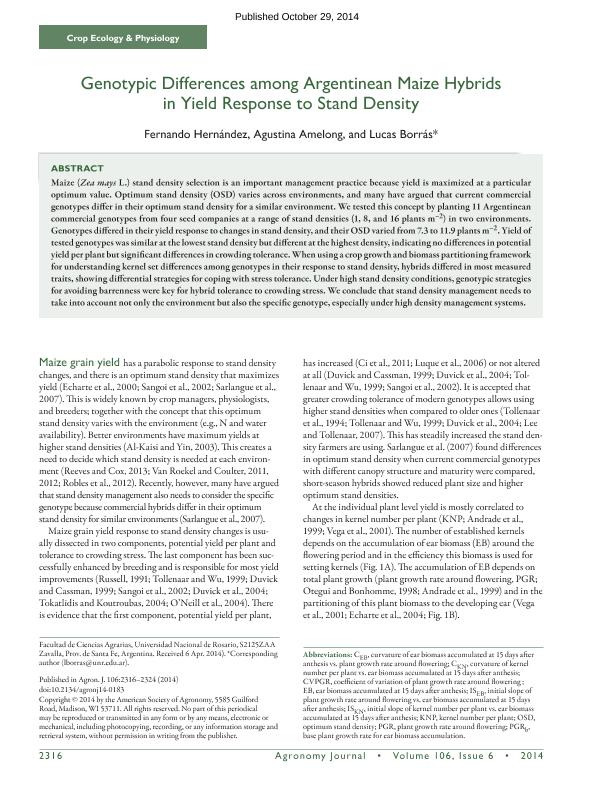Mostrar el registro sencillo del ítem
dc.contributor.author
Hernández, Fernando

dc.contributor.author
Amelong, Agustina

dc.contributor.author
Borras, Lucas

dc.date.available
2017-12-13T13:48:53Z
dc.date.issued
2014-10
dc.identifier.citation
Hernández, Fernando; Amelong, Agustina; Borras, Lucas; Genotypic Differences among Argentinean Maize Hybrids in Yield Response to Stand Density; Amer Soc Agronomy; Agronomy Journal; 106; 6; 10-2014; 2316-2324
dc.identifier.issn
0002-1962
dc.identifier.uri
http://hdl.handle.net/11336/30377
dc.description.abstract
Maize (Zea mays L.) stand density selection is an important management practice because yield is maximized at a particularoptimum value. Optimum stand density (OSD) varies across environments, and many have argued that current commercialgenotypes differ in their optimum stand density for a similar environment. We tested this concept by planting 11 Argentineancommercial genotypes from four seed companies at a range of stand densities (1, 8, and 16 plants m?2) in two environments.Genotypes differed in their yield response to changes in stand density, and their OSD varied from 7.3 to 11.9 plants m?2. Yield oftested genotypes was similar at the lowest stand density but different at the highest density, indicating no differences in potentialyield per plant but significant differences in crowding tolerance. When using a crop growth and biomass partitioning frameworkfor understanding kernel set differences among genotypes in their response to stand density, hybrids differed in most measuredtraits, showing differential strategies for coping with stress tolerance. Under high stand density conditions, genotypic strategiesfor avoiding barrenness were key for hybrid tolerance to crowding stress. We conclude that stand density management needs totake into account not only the environment but also the specific genotype, especially under high density management systems.
dc.format
application/pdf
dc.language.iso
eng
dc.publisher
Amer Soc Agronomy

dc.rights
info:eu-repo/semantics/openAccess
dc.rights.uri
https://creativecommons.org/licenses/by-nc-sa/2.5/ar/
dc.subject
Maize
dc.subject
Stand Density
dc.subject
Yield
dc.subject
Optimum Stand Density
dc.subject.classification
Agricultura

dc.subject.classification
Agricultura, Silvicultura y Pesca

dc.subject.classification
CIENCIAS AGRÍCOLAS

dc.title
Genotypic Differences among Argentinean Maize Hybrids in Yield Response to Stand Density
dc.type
info:eu-repo/semantics/article
dc.type
info:ar-repo/semantics/artículo
dc.type
info:eu-repo/semantics/publishedVersion
dc.date.updated
2017-12-12T18:22:33Z
dc.journal.volume
106
dc.journal.number
6
dc.journal.pagination
2316-2324
dc.journal.pais
Estados Unidos

dc.journal.ciudad
Madison
dc.description.fil
Fil: Hernández, Fernando. Universidad Nacional de Rosario. Facultad de Ciencias Agrarias. Cátedra de Cultivo Extensivos Cereales y Oleaginosas; Argentina. Consejo Nacional de Investigaciones Científicas y Técnicas; Argentina
dc.description.fil
Fil: Amelong, Agustina. Universidad Nacional de Rosario. Facultad de Ciencias Agrarias. Cátedra de Cultivo Extensivos Cereales y Oleaginosas; Argentina. Consejo Nacional de Investigaciones Científicas y Técnicas; Argentina
dc.description.fil
Fil: Borras, Lucas. Universidad Nacional de Rosario. Facultad de Ciencias Agrarias. Cátedra de Cultivo Extensivos Cereales y Oleaginosas; Argentina. Consejo Nacional de Investigaciones Científicas y Técnicas; Argentina
dc.journal.title
Agronomy Journal

dc.relation.alternativeid
info:eu-repo/semantics/altIdentifier/url/https://dl.sciencesocieties.org/publications/aj/abstracts/106/6/2316
dc.relation.alternativeid
info:eu-repo/semantics/altIdentifier/doi/http://dx.doi.org/10.2134/agronj14.0183
Archivos asociados
